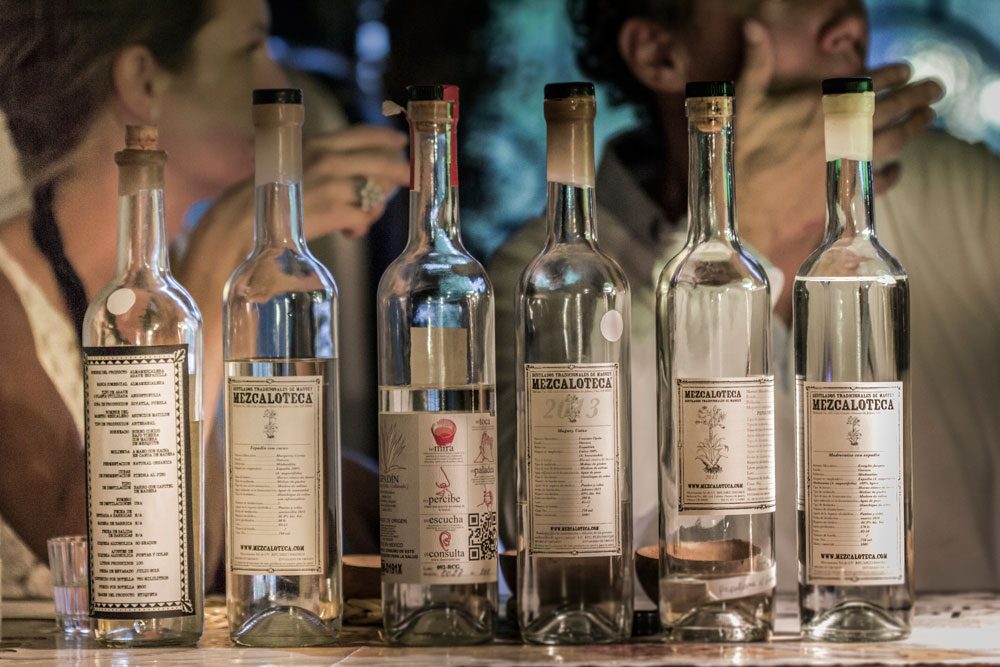“Mezcal has been produced here in Oaxaca for at least four hundred years,” Silvia Philion tells me from behind the bar at Mezcaloteca, one of the city’s most prominent mezcalerias. After several years marketing traditional mezcal in Mexico City, her and her partner founded the business five years ago as a way to connect mezcal lovers to traditional maestro mezcaleros – master mezcal makers – from various towns in the southern state.
While mezcal is developing a reputation for its complexity and richness, both in culture and flavor, it hasn’t always been this way. For hundreds of years after the Spanish arrived, bringing the distillation process with them, mezcal was made in several states in Mexico using traditional methods: mature magueye plants, some of them decades old, are crushed by hand or by stone, fermented in barrels or pits, then distilled in copper or clay to a potent liquor.
“Traditional mezcal,” Silvia says after teaching me the proper way to sip from the jicarita, a small half-gourd, “is always at least 45% alcohol.” More importantly, traditional mezcal is made by maestro mezcaleros who produce spirits, using local cultivated or wild plants, and specific methods, in order to produce a liquor to the preference of the local townspeople. “Every village has its own prefered flavor, and traditional mezcal is always made for the people in the town where it is produced.” [pagebreak]
Mezcal has never really been popular in a commercial sense, Silvia tells me. It may have a growing following among food-lovers and trendsetters, but it’s still a small industry with a complex reputation. Since industrial alcohol became easy to buy and popular in Mexican cities, urbanites have looked down on the drink, something they view as, essentially, country hooch.
It was this relative obscurity, however, that may have saved Mexico’s mezcal traditions. “Look at tequila, which is a kind of mezcal,” Silvia says, lowering her voice. “It became popular quickly, industry bought it up, and so many traditions were lost.”
She’s quick to point out that a modern fascination with artisanal products isn’t necessarily going to save mezcal, but it has helped shine a light on the product and its producers. “Artisanal mezcales are often made with traditional methods, but they are created for a brand. The company tells the maestro mezcalero what they want and he makes it to their preference.” In other words, artisanal brands may help preserve skills, but not centuries-old regional recipes. [pagebreak]
One of the biggest challenges to modernization is that often, traditional mezcaleros aren’t sure how to price their product for mass consumption. Many, she said, sell their mezcal for as little as 30 pesos a liter, less than $2 US, a price at which they are losing money. At Mezcaloteca, they work with dozens of different producers, helping them to not only preserve their traditional recipes, but to make a decent living from it as well.
In particular, her and her partner work with as many young mezcaleros as they can. “They’re the future of mezcal,” she says about the producers of the varieties she has chosen for me to taste. “Without them, our traditions will be lost.”
Silvia doesn’t resent artisanal or even industrial producers. There is room for everyone in mezcal, she says. “Try an industrial espadin,” she urges, naming the most common maguey used in mezcal production. “Try an artisanal madre cuish. Try something traditional, try something rare… People come and ask me to pour them the best mezcal. There’s no such thing. It’s all about the taste that you prefer.” That is how mezcal is made to be – a drink around which communities gather around the love of a shared flavor.


![Making Mealtime Matter with La Familia: Easy Sofrito [Video]](https://thelatinkitchen.com/wp-content/uploads/2015/10/sofrito-shutterstock__0-500x383.jpg)
![Easy Latin Smoothies: Goji Berry Smoothie [Video]](https://thelatinkitchen.com/wp-content/uploads/2015/12/goji_berry-shutterstock_-500x383.jpg)
















![Fun and Fast Recipes: Fiesta Cabbage Salad [Video]](https://thelatinkitchen.com/wp-content/uploads/2015/11/fiesta_cabbage_slaw-shutterstock_-500x383.jpg)









